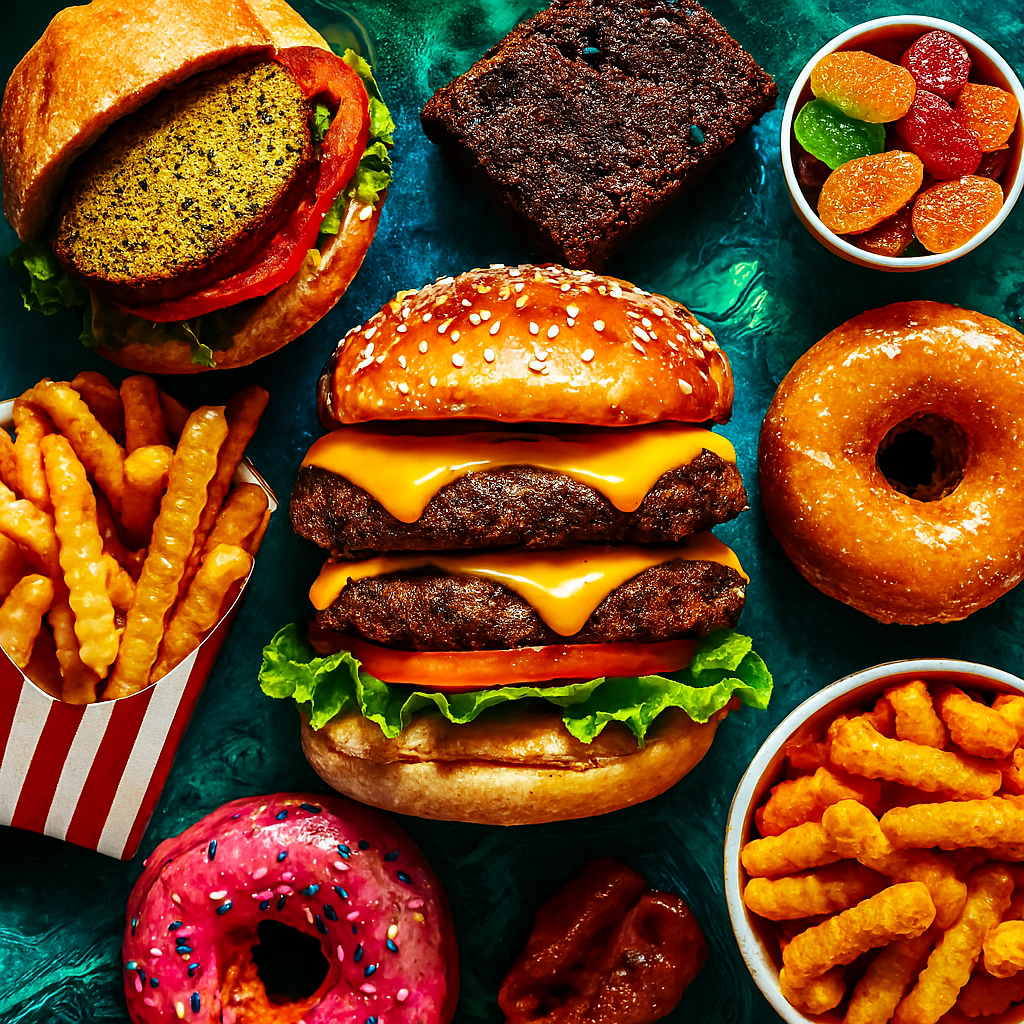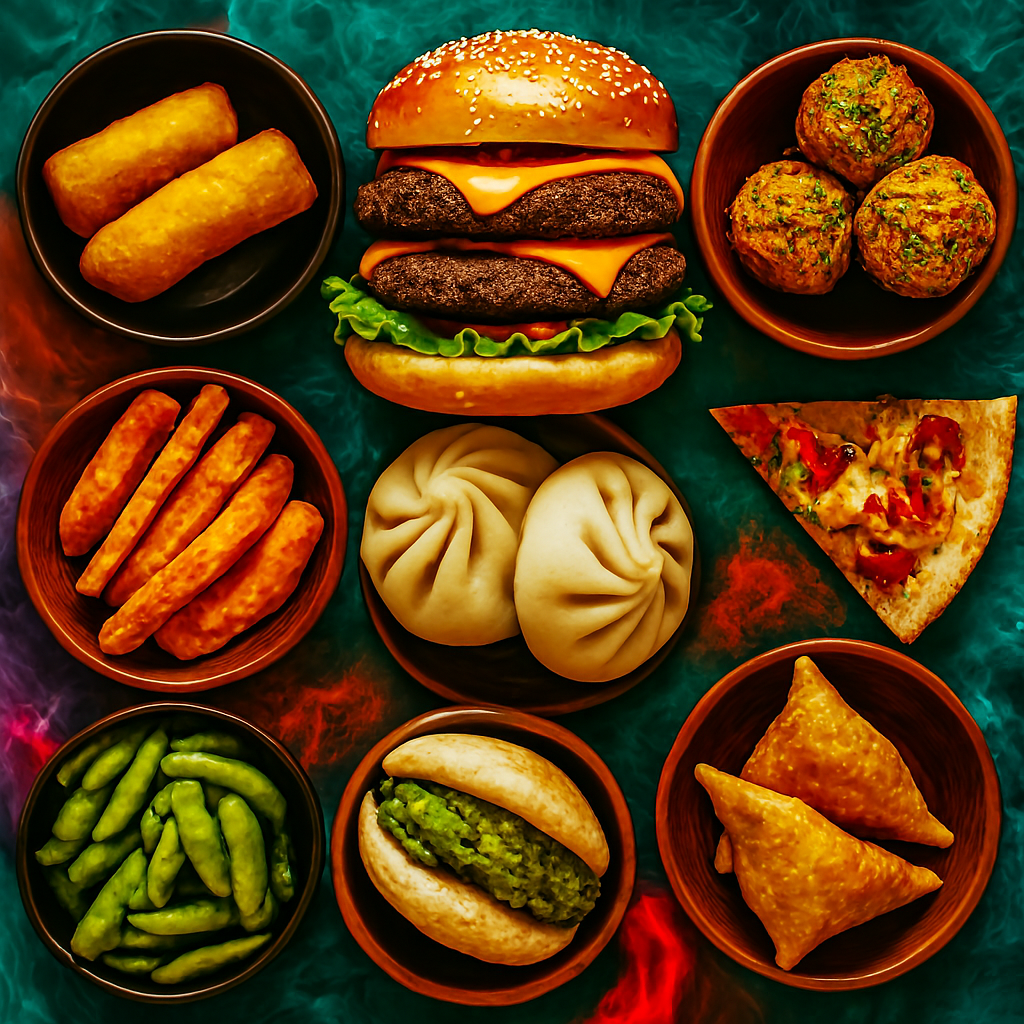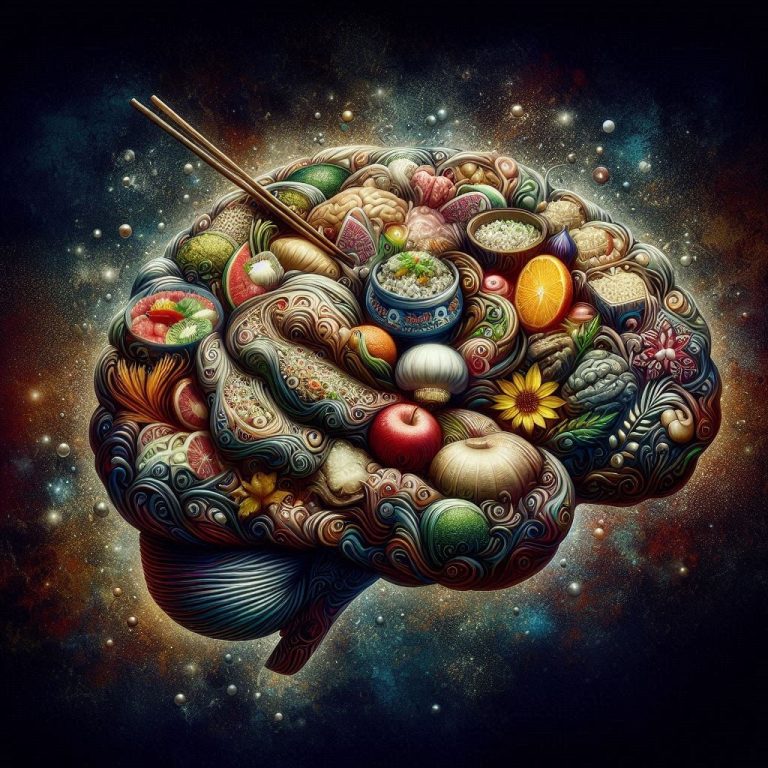YUMMY HAPPY FAST FOOD AND JUNK FOOD PSYCHOLOGY
The Hidden Drivers Behind Our Appetite for Processed Pleasure
INTRODUCTION
Fast food and junk food are more than just convenient meals—they are cultural artifacts shaped by biology, emotion, and environment. Their appeal is engineered to satisfy ancient instincts while fitting seamlessly into modern routines. These foods offer immediate gratification with minimal effort, making them ideal for fast-paced lifestyles. They are designed to trigger pleasure, soothe stress, and reinforce habits. From drive-thrus to vending machines, their presence is constant and accessible. The craving is not just about hunger—it is about comfort, memory, and ritual.
FAST FOOD AND JUNK FOOD
EVOLUTION’S TASTE FOR ENERGY
Humans evolved in environments where food scarcity was a constant threat. Our ancestors survived by seeking out calorie-dense foods that could sustain long periods of exertion. Fat, sugar, and salt signaled safety and survival, making them highly desirable. Today, fast food and junk food mimic those ancient rewards with concentrated energy in compact forms. The brain still interprets these foods as beneficial, even when they lack nutritional value. This evolutionary echo makes processed foods feel comforting and necessary.
The craving is not weakness—it is a survival instinct misfiring in a world of abundance. Fast food chains exploit this instinct with engineered flavor and rapid delivery. Junk food amplifies it with textures and additives that mimic natural satisfaction. Our biology has not caught up with our environment, and that mismatch fuels the craving.

THE CHEMISTRY OF CRAVING
Fast food and junk food are built around precise combinations of sugar, salt, and fat. These ingredients are calibrated to hit pleasure receptors in the mouth and brain. Salt enhances flavor and suppresses bitterness, while sugar adds sweetness and energy. Fat provides richness and mouthfeel, creating a layered sensory experience. These combinations bypass natural satiety signals, encouraging overconsumption. The pleasure is immediate, but the nutritional value is often low. This engineered chemistry makes processed foods feel irresistible. It is not just taste—it is a formula designed to override restraint. The result is a cycle of craving, consumption, and reward that is difficult to break. Understanding this chemistry helps explain why moderation is so elusive.
EMOTIONAL COMFORT AND FOOD RITUALS
Stress, sadness, boredom, and fatigue all increase the appeal of fast food and junk food. These foods offer immediate relief with no preparation or cleanup. They become emotional tools used to soothe discomfort or reward effort. Over time, the brain links these foods with comfort and safety. This connection becomes automatic, especially during moments of vulnerability. Fast food chains reinforce this with nostalgic menus and familiar branding. Junk food packaging often evokes childhood memories or seasonal joy. The emotional bond is strong and reinforced by repetition. Eating becomes a ritual of reassurance rather than nourishment. Breaking that cycle requires new emotional anchors and alternative comforts.
FAST FOOD AND JUNK FOOD PSYCHOLOGY
CULTURAL HABITS AND SOCIAL SIGNALS
Fast food is more than a meal—it is a shared experience embedded in modern culture. From birthday parties to road trips, it plays a role in social bonding. Junk food appears at movie nights, sleepovers, and celebrations. These foods carry social meaning, signaling fun, freedom, and togetherness. Cultural habits normalize their presence, making them feel essential rather than optional. Advertising amplifies this by portraying processed foods as youthful and exciting. Social media adds another layer, turning meals into content and consumption into identity. The result is a landscape where fast food is not just accepted—it is celebrated. Changing these norms requires new rituals and shared values. It is not just about education—it is about emotional replacement.
THE SPEED OF MODERN LIFE
Time scarcity drives food choices in fast-paced environments. When schedules are packed and energy is low, fast food becomes the default. It is quick, predictable, and available almost everywhere. Junk food fits into pockets of time—between meetings, during commutes, or late at night. Convenience is a powerful motivator that often outweighs health concerns. Fast food chains design their spaces for efficiency and impulse. Junk food is placed strategically in stores and vending machines for maximum visibility. These foods are always within reach, making them hard to resist. The pace of life shapes the pace of eating. Slowing down requires intention, access, and support.

BRANDING AND EMOTIONAL MEMORY
Logos, colors, mascots, and jingles create emotional connections with food. Fast food chains invest heavily in brand identity to make their products instantly recognizable. Junk food brands use humor, nostalgia, and seasonal themes to build trust. These cues trigger emotional memory, linking products with moments of joy or comfort. Loyalty programs and app rewards deepen the bond, turning purchases into rituals. The result is a psychological ecosystem that supports habitual consumption. These strategies are subtle but powerful and shape perception and behavior. Recognizing them is the first step toward conscious choice. Branding is not just marketing—it is emotional architecture. It builds familiarity, trust, and craving.
CHILDHOOD TASTES THAT STICK
Early exposure to fast food and junk food shapes lifelong preferences. Children are drawn to sweetness, crunchiness, and bright colors. These sensory cues create positive associations that persist into adulthood. Fast food chains target kids with toys, play areas, and cartoon mascots. Junk food brands sponsor school events and youth activities to build familiarity. These experiences embed processed foods into memory and routine. The brain links them with safety, reward, and celebration. Over time, these preferences become part of identity and habit. Changing them requires new experiences, not just new information. Childhood taste memory is powerful—but it can be rewritten with care and creativity.

TEXTURE AND MOUTHFEEL ENGINEERING
Processed foods are designed to feel good in the mouth. Crunch, creaminess, chewiness, and temperature contrast all enhance pleasure. Fast food uses crispy fries, juicy burgers, and fizzy drinks to stimulate the senses. Junk food relies on emulsifiers and stabilizers to create ideal textures. These effects are refined to maximize appeal and prolong consumption. Mouthfeel influences satisfaction even more than flavor. It affects how long we eat, how much we eat, and how we remember the experience. Texture science is a key reason why processed foods outperform homemade meals in sensory appeal. It is not just taste—it is tactile design. The craving begins with how food feels, not just how it tastes.
PROCESSED FOOD AND JUNK FOOD
PACKAGING THAT SHAPES PERCEPTION
Packaging influences how we perceive portion size, value, and health. Fast food uses combo deals and upsizing to encourage larger purchases. Junk food uses resealable bags and single-serve packs to suggest moderation. These cues affect how much we eat and how guilty we feel. Visual design, portion framing, and price anchoring all play a role. Consumers often underestimate calories based on packaging. Fast food wrappers create a sense of casual indulgence. Junk food packaging uses transparency and health buzzwords to reduce hesitation. These tactics are not accidental—they are behavioral design. Awareness is key to resisting manipulation.
URBAN ACCESS AND FOOD AVAILABILITY
In many cities, fresh produce and whole foods are harder to find than fast food. Processed options dominate convenience stores, gas stations, and transit hubs. This creates a structural reliance on junk food, especially in low-income areas. Fast food chains cluster near schools, workplaces, and apartment complexes. Junk food fills the gaps in availability and affordability. The result is a food landscape shaped by access, not preference. Changing this requires urban planning, community investment, and policy support. It is not just about personal choice—it is about systemic design. Where we live affects what we eat. Accessibility drives consumption more than intention.
REWARD CYCLES AND REPETITION
Fast food and junk food trigger reward cycles that reinforce behavior. Each bite activates pleasure centers in the brain, creating a feedback loop. The more often we eat these foods, the stronger the association becomes. Repetition builds habit, and habit builds identity. These cycles are difficult to break because they are emotionally and neurologically reinforced. Fast food chains encourage repetition with loyalty programs and limited-time offers. Junk food brands use seasonal flavors and collectible packaging to keep consumers engaged. The result is a loop of craving, consumption, and reinforcement. Breaking the cycle requires conscious interruption and new rituals. Awareness is a minset of understanding food and is the first step toward change.
PORTION DISTORTION AND VALUE PERCEPTION
Fast food and junk food often distort portion expectations. Large servings are marketed as better value, encouraging overconsumption. Combo meals and upsizing create a sense of abundance and reward. Junk food packaging uses visual tricks to make portions seem smaller or healthier. These distortions affect how much we eat and how we feel about it. Consumers often equate quantity with satisfaction, even when quality is lacking. Fast food chains use pricing strategies to make larger portions more appealing. Junk food brands rely on impulse and convenience to drive volume. The result is a skewed perception of what a normal portion looks like. Recalibrating portion awareness is essential for mindful eating.

FLAVOR MEMORY AND SENSORY IMPRINTS
Flavor memory plays a powerful role in food preference. The brain stores sensory experiences and links them to emotions and environments. Fast food flavors are designed to be memorable and comforting. Junk food uses artificial flavoring to create distinct and lasting impressions. These sensory imprints influence future cravings and choices. A single positive experience can shape long-term behavior. Flavor becomes a shortcut to emotional relief or nostalgia. Fast food chains replicate flavor profiles across locations to maintain consistency. Junk food brands rely on signature tastes to build loyalty. Flavor memory is not just about taste—it is about emotional imprint.
THE VEGAN CHANGE
VEGANISM AND DIETARY REQUIREMENTS IN A PROCESSED FOOD LANDSCAPE
Dietary restrictions are reshaping how people interact with fast food and junk food ecosystems. Veganism, lactose intolerance, gluten sensitivity, and religious food laws all create boundaries that traditional menus often ignore. Most fast food chains were built around meat, dairy, and refined starches—leaving little room for plant-based or allergen-free alternatives. Even when vegan options appear, they often rely on ultra-processed substitutes that mimic animal products but carry their own nutritional concerns. Cross-contamination remains a major issue, especially in kitchens that share fryers, grills, and prep surfaces.
Ingredient transparency is inconsistent, with many chains using proprietary blends that obscure additives and allergens. Junk food brands have introduced gluten-free and dairy-free versions, but these often contain emulsifiers, artificial flavors, and stabilizers that complicate digestion. For people with strict dietary needs, navigating fast food involves risk management, label scrutiny, and compromise. The craving for convenience does not vanish—it adapts to new constraints and rituals. True inclusion in food design means building menus from the ground up—not retrofitting old systems with token alternatives.
CONCLUSION
Our love for fast food and junk food is not a mystery—it is a complex interplay of biology, emotion, culture, and environment. These foods are engineered to satisfy ancient instincts, soothe modern stress, and fit into fast-paced lives. They are marketed with precision and embedded in memory. Recognizing these forces does not mean rejecting pleasure—it means reclaiming choice. By understanding the drivers behind our cravings, we can build new habits, new rituals, and new relationships with food. The goal is not perfection—it is awareness. Craving is natural. Consciousness is powerful. Change begins with understanding. The appetite for clarity is just as important as the appetite for flavor.
JOIN THE DISCUSSION
What role does fast food or proccessed foor play in your life and how does it change you ? Is it comfort, convenience, or culture?
#FastFoodCulture #CravingDecoded #FoodPsychology #ComfortEating #UrbanFoodDesign #TextureMatters #EmotionalEating #BrandInfluence #FoodHabits #MindfulEating #ProcessedPleasure #FoodIdentity #TasteMemory #ConvenienceCulture #FoodAwareness








One Comment